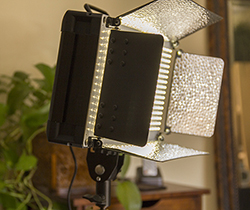Adorama introduces another hit in their line of affordable video and photo lights, with the Flashpoint 500C – a 500 LED portable light panel that features adjustable dual color temperatures and output running on either AC or battery power (battery not included), works on overseas voltage and includes sturdy, built-in reflective barn doors – all for about $200.
First Impressions
Right out of the box, I was impressed with the build quality of this light panel. Constructed with durable PVC plastic and aluminum, but definitely solid enough to withstand a lot of use and packing/transporting. I've seen other manufactures' lights that don't have near the build quality of the Flashpoint 500C at a much higher price!
The Flashpoint 500C light kit comes with the AC adapter/power cord, folding reflective barn doors and a mounting bracket for a standard light stand. It also has a built-in metal handle for moving/holding the light by hand. I found that the handle is also useful for hanging and clamping the light to just about anything.
![]()
![]()
It also has a V-mount battery pack base (battery not included) and will work with any 48V AC connection with XLR cable. Two separate dimmers for each warm (3200 K) and daylight (5900 K) color temperatures, controlling the 500 super-bright LEDs. Since I didn't have a battery to test the unit with, I have no information about battery output or run-time on a single charge, but my assumption is that the batter may be charged while mounted to the light fixture via the V-mount, according to the description imprinted on the back of the device. [The V Lock Li-ion battery listed on their site is also $200.]
Initial Testing
Plugging in the light and testing the output of the LEDs and their color temp/brightness, you can see that there are alternating rows of the dual-colored LEDs in a grid that holds the 500 LEDs.
Lighting a white card and shooting through a Sony EX3 to read the WB automatically, you can see the results in the extremities of adjustments. Of course, a proper light meter/colorometer is necessary for accurate readings – this is just a practical test.
Practical Application
I found the light very easy to use and dial in for various lighting scenarios – including a mix of other LED lights and daylight from a nearby window. I was using a single Lowel Blender on a high-mount for a hair light and a 5×6' window on the right side of the piano and adjusted the Flashpoint to give a larger, soft combination between the two light sources. The in-camera result show below.
Product Overview
I found the Flashpoint 500C to be a great addition to my existing smaller Lowel Blender kit for not only low-voltage portability, but the color-matching range of the LEDs and soft, wide throw, which effectively replaces a softbox for single-subject interview shots… esp[ecially at such an affordable price-point!
My only request for this light would be that it came with a single On/Off toggle so I could leave the color temp adjustments set for prolonged shoots without having to pull the power or use an external switch, as the power on/off is built into the dimmer dials.
But at the $200 price point, I could easily see buying several of these for a production at the price of renting only a few of the competitor's lights for a weekend.
Visit the Adorama website for more information and to purchase the Flashpoint 500C and accessories.
Info from the Adorama website:
Key Features
- 50%-5900 K (Kelvin) Color Temperature
- 50%-3200 K (Kelvin) Color Temperature
- Two-Way Switch turns on all 500 bulbs or 250 bulbs [Note: there are two separate Off/Dimmer switches – one for each color bank]
- Will Work off AC V style battery pack or XLR connection
- Uses 500 Ultra Bright LED's (5mm Bulbs)
- 4 Barndoors for Directional Lighting
- 13' Long Power Cord
- Lightweight – Only 6 Pounds
- Power output 42W
Technical Specs
- Light Temperature 5200-5800K
- Light Dimensions 35 cm X 19 cm X 7 cm / 14″ X 7½” X 2 ¾”
- OutPut ,250 lux @ 2.0' (61 cm)
- 1,350 lux @ 4.0' (122 cm)
- 530 lux @ 6.0' (182 cm)
_________________________________________________________________
Jeff Foster is a published author of several how-to books and training videos in the motion graphics, animation and video production industries and is an award-winning video producer and artist. Visit his web site to learn more about his training methods, tips & tricks at PixelPainter.com


